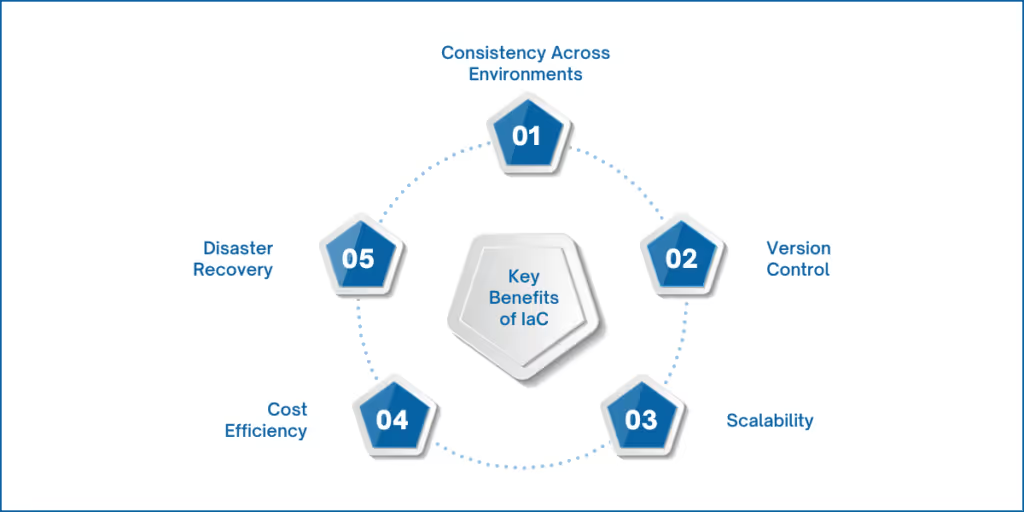

The concept of Infrastructure as Code (IaC) began as a response to the challenges of managing increasingly complex IT environments. In the early days, infrastructure was provisioned manually, leading to errors and inefficiencies. With the advent of virtualization and cloud computing, organizations needed a better way to manage resources.
IaC provided that solution by enabling infrastructure to be managed through code, bringing automation and consistency to the forefront. By treating infrastructure as code, businesses can define, provision, and manage their systems just like software.
This approach eliminates manual processes, reduces errors, and allows for rapid scaling. Today, IaC is a cornerstone of modern IT operations and plays a critical role in the success of DevOps practices.
This blog explores the principles, approaches, and benefits of IaC, as well as its indispensable role in the DevOps ecosystem.
Infrastructure as Code (IaC) is the practice of managing and provisioning infrastructure through machine-readable configuration files instead of traditional manual processes. These configurations define the desired state of systems, networks, and other infrastructure components, enabling repeatable and reliable deployments.
By automating infrastructure management, IaC streamlines workflows, reduces errors, and accelerates development, testing, and deployment. For your team, it bridges the gap between development and operations by treating infrastructure like application code—version-controlled, tested and continuously improved—allowing for faster and more efficient processes that support high-quality, scalable applications.
IaC operates by translating high-level infrastructure requirements into code that is executed by automation tools. This approach enables organizations to standardize and automate the deployment process, reducing human error and ensuring consistency across environments. There are two main approaches to IaC:
The declarative approach focuses on describing the desired state of the infrastructure without specifying the steps to achieve it. For example, you define that a server should exist with specific configurations, and the tool ensures the infrastructure aligns with that state. Tools like Terraform and CloudFormation follow this model, making it easier to manage complex systems.
In contrast, the imperative approach specifies the exact sequence of steps to achieve the desired infrastructure state. This approach provides more control but requires detailed instructions for every change. Tools like Ansible often use an imperative model, making them suitable for procedural tasks and fine-grained adjustments.
By leveraging both approaches, organizations can choose the right strategy depending on the complexity and nature of their infrastructure needs.

Infrastructure as Code offers a plethora of advantages that extend beyond automation. Some of the most notable benefits include the following:
Now that we've covered the key benefits of Infrastructure as Code (IaC), let's dig deeper into the core principles that make IaC a powerful tool for your team. Understanding these principles will help you implement IaC effectively, ensuring that you maximize its potential and enhance collaboration across your organization.

1. Effortless System Rebuilds
The ability to rebuild infrastructure components effortlessly eliminates the need for decision-making during restoration. By embedding configurations like hostnames, applications, and versions in scripts, you ensure smooth rebuilds.
This capability minimizes risks and enhances confidence when making changes. Failures can be addressed quickly, and new ecosystems can be provisioned with minimal effort. It supports consistent, scalable operations without fear of disruption.
2. Adaptable and Disposable Infrastructure
Dynamic infrastructures allow you to build, destroy, upgrade, and transfer resources seamlessly. Systems should be designed to handle frequent changes, ensuring applications run reliably even when servers are resized or replaced.
This adaptability increases fault tolerance and simplifies upgrades and fixes. By leveraging cloud infrastructure, you gain the ability to manage unreliable hardware with software designed for resilience, ensuring reliability in shared environments.
3. Real-Time Self-Documenting Systems
Maintaining accurate documentation is challenging, as traditional records often lag behind real-world changes. With IaC, scripts and configuration files capture the exact steps for processes, reducing reliance on outdated manuals.
This live documentation ensures processes stay synchronized with changes, providing an always-relevant reference. Minimal additional documentation is required, and updates are kept close to the system for ease of access and accuracy.
4. Evolving Designs for Modern Needs
Legacy systems are costly and difficult to change, leading to overly complex designs. Dynamic infrastructures make changes affordable and simple, provided they are designed to facilitate change.
Frequent updates encourage streamlined processes, robust tooling, and efficient workflows. Building systems for flexibility allows them to meet evolving needs and enables safe, rapid changes, fostering a culture of continuous improvement.
5. Reusable and Modular Frameworks
IaC supports creating reusable modules, allowing IT and DevOps teams to integrate new cloud-native applications with traditional software environments. This approach ensures developers focus on code while IT supports operational requirements.
A generic framework facilitates continuous evolution, helping DevOps teams manage application lifecycles efficiently. It bridges the gap between development and operations, improving collaboration and scalability.
6. Unified APIs for Streamlined Automation
Unified APIs enable developers to dynamically allocate resources—computing, storage, and networking—at runtime with minimal scripting. REST-based APIs with language bindings (e.g., Java, Python) integrate seamlessly into DevOps tools like Chef and Ansible.
This simplifies infrastructure management, allowing developers to focus on applications without needing deep architectural knowledge. Intelligent software allocates the precise resources required, ensuring efficiency and consistency.
Now that we've covered the key principles, let's explore IaC's crucial role in the DevOps lifecycle and how it makes a difference.
Infrastructure as Code (IaC) has become essential for organizations adopting DevOps. With the global IaC market growing from $0.8 billion in 2022 to an expected $2.3 billion by 2027, its importance in modern workflows is clear.
DevOps is all about automation, and IaC plays a key role in automating infrastructure management. This ensures your systems are consistent, efficient, and scalable—all vital for DevOps success. Here are some ways IaC enhances DevOps processes:
As we've seen, IaC plays a vital role in transforming the way DevOps teams manage infrastructure. To wrap things up, let's take a moment to reflect on its overall impact and how it drives efficiency, consistency, and scalability in modern software development.
Infrastructure as Code (IaC) has revolutionised the way teams manage and provision infrastructure, offering a more efficient, reliable, and automated approach compared to traditional methods.
Embracing IaC not only streamlines workflows but also empowers teams to deliver high-quality applications faster, making it an essential tool in modern software development.
WaferWire provides tailored Infrastructure as Code (IaC) strategies designed to meet the unique needs of your business. Here’s how we can help:
Let WaferWire help you take your IT infrastructure to the next level.
Ready to future-proof Your IT Operations?
Contact us today to explore how we can help transform and drive your business forward!

